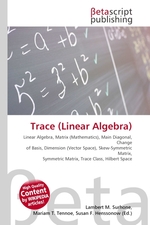Trace (Linear Algebra)
Lambert M. Surhone, Miriam T. Timpledon, Susan F. Marseken
бумажная книга
High Quality Content by WIKIPEDIA articles! In linear algebra, the trace of an n-by-n square matrix A is defined to be the sum of the elements on the main diagonal (the diagonal from the upper left to the lower right) of A, i.e., mathrm{tr}(A) = a_{11} + a_{22} + dots + a_{nn}=sum_{i=1}^{n} a_{i i} , where aij represents the entry on the ith row and jth column of A. Equivalently, the trace of a matrix is the sum of its eigenvalues, making it an invariant with respect to a change of basis. This characterization can be used to define the trace for a linear operator in general. Note that the trace is only defined for a square matrix (i.e. nxn). Geometrically, the trace can be interpreted as the infinitesimal change in volume (as the derivative of the determinant), which is made precise in Jacobi's formula. The use of the term trace arises from the German term Spur (cognate with the English spoor), which, as a function in mathematics, is often abbreviated to "Sp".
Данное издание не является оригинальным. Книга печатается по технологии принт-он-деманд после получения заказа.


